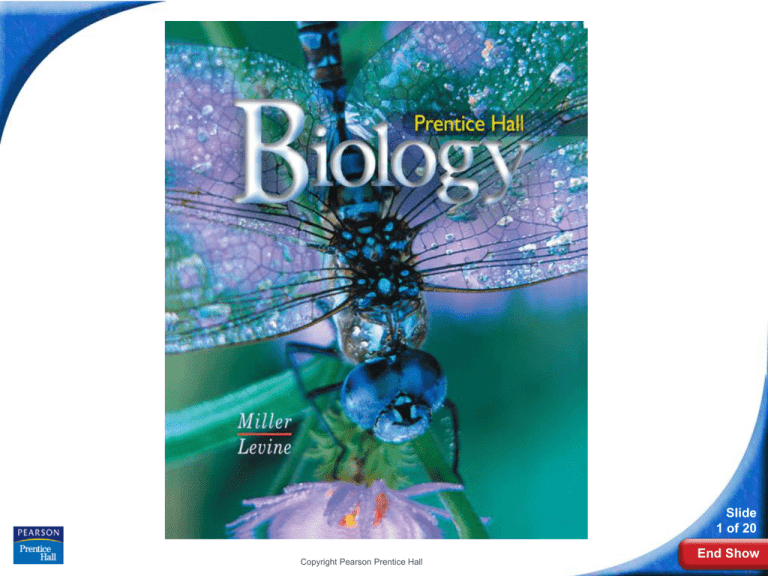
Biology
Slide
1 of 20
Copyright Pearson Prentice Hall
End Show
8-1 Energy and Life
Slide
2 of 20
Copyright Pearson Prentice Hall
End Show
8-1 Energy And Life
Autotrophs and Heterotrophs
Living things need energy to survive.
This energy comes from food. The energy in
most food comes from the sun.
Where do plants get the energy they need
to produce food?
Slide
3 of 20
Copyright Pearson Prentice Hall
End Show
8-1 Energy And Life
Autotrophs and Heterotrophs
Autotrophs and Heterotrophs
Plants and some other types of
autotrophic organisms are able to use
light energy from the sun to produce food.
Others, heterotrophic organisms need
to eat other organisms to get energy
Slide
4 of 20
Copyright Pearson Prentice Hall
End Show
8-1 Energy And Life
Chemical Energy and ATP
Chemical Energy and ATP
Energy comes in many forms including light, heat,
and electricity.
Energy can be stored in chemical compounds, too.
Slide
5 of 20
Copyright Pearson Prentice Hall
End Show
8-1 Energy And Life
Chemical Energy and ATP
An important chemical compound that cells use to
store and release energy is adenosine
triphosphate, abbreviated ATP.
ATP is used by all types of cells as their basic
energy source.
Slide
6 of 20
Copyright Pearson Prentice Hall
End Show
8-1 Energy And Life
Chemical Energy and ATP
ATP consists of:
• adenine
• ribose (a 5-carbon sugar)
• 3 phosphate groups
Adenine
Ribose
3 Phosphate groups
Slide
7 of 20
ATP
Copyright Pearson Prentice Hall
End Show
8-1 Energy And Life
Chemical Energy and ATP
Storing Energy
ADP has two phosphate groups instead of three.
A cell can store small amounts of energy by adding
a phosphate group to ADP.
ATP
ADP
+
Adenosine Diphosphate
(ADP) + Phosphate
Partially
charged
battery
Energy
Energy
Fully
charged
battery
Copyright Pearson Prentice Hall
Adenosine Triphosphate (ATP)
Slide
8 of 20
End Show
8-1 Energy And Life
Chemical Energy and ATP
Releasing Energy
Energy stored in ATP is released by breaking the
chemical bond between the second and third
phosphates.
2 Phosphate groups
P
ADP
Slide
9 of 20
Copyright Pearson Prentice Hall
End Show
8-1 Energy And Life
Chemical Energy and ATP
What is the role of ATP in cellular
activities?
Slide
10 of 20
Copyright Pearson Prentice Hall
End Show
8-1 Energy And Life
Chemical Energy and ATP
The energy from ATP is needed for many
cellular activities, including active transport
across cell membranes, protein synthesis and
muscle contraction.
ATP’s characteristics make it exceptionally
useful as the basic energy source of all
cells.
Slide
11 of 20
Copyright Pearson Prentice Hall
End Show
8-1 Energy And Life
Using Biochemical Energy
Using Biochemical Energy
Most cells have only a small amount of ATP,
because it is not a good way to store large
amounts of energy.
Cells can regenerate ATP from ADP as needed by
using the energy in foods like glucose.
Slide
12 of 20
Copyright Pearson Prentice Hall
End Show
8-1
Click to Launch:
Continue to:
- or -
Slide
13 of 20
End Show
Copyright Pearson Prentice Hall
8-1
Organisms that make their own food are called
a. autotrophs.
b. heterotrophs.
c. decomposers.
d. consumers.
Slide
14 of 20
End Show
Copyright Pearson Prentice Hall
8-1
Most autotrophs obtain their energy from
a. chemicals in the environment.
b. sunlight.
c. carbon dioxide in the air.
d. other producers.
Slide
15 of 20
End Show
Copyright Pearson Prentice Hall
8-1
How is energy released from ATP?
a. A phosphate is added.
b. An adenine is added.
c. A phosphate is removed.
d. A ribose is removed.
Slide
16 of 20
End Show
Copyright Pearson Prentice Hall
8-1
How is it possible for most cells to function
with only a small amount of ATP?
a. Cells do not require ATP for energy.
b. ATP can be quickly regenerated from
ADP and P.
c. Cells use very small amounts of
energy.
d. ATP stores large amounts of energy.
Slide
17 of 20
End Show
Copyright Pearson Prentice Hall
8-1
Compared to the energy stored in a molecule of
glucose, ATP stores
a. much more energy.
b. much less energy.
c. about the same amount of energy.
d. more energy sometimes and less at others.
Slide
18 of 20
End Show
Copyright Pearson Prentice Hall
END OF SECTION



